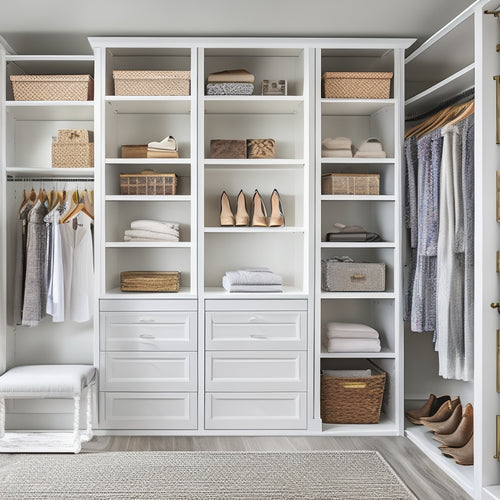
What to Consider When Downsizing for Seniors
Share
As you downsize for your senior years, you'll encounter sentimental items, family heirlooms, and important documents that need attention. Identify essential belongings, prioritize cherished photos, and consider regular-use items like cooking utensils and clothing. Take precise measurements of furniture and new home spaces to guarantee a smooth shift. You'll need to balance the needs of different age groups in multi-generational homes and create a functional floor plan. Don't forget to utilize hidden compartments for storage and manage papers and documents digitally. As you navigate this process, remember that adapting to a smaller living space requires compromise, flexibility, and a clear understanding of what truly matters – and that's just the beginning of your journey.
Key Takeaways
• Identify sentimental items, prioritize cherished possessions, and consider letting go of non-essential items that no longer bring joy or serve a purpose.
• Measure furniture and new living spaces precisely to ensure a smooth transition and avoid costly mistakes.
• Balance the needs of different age groups in multi-generational homes by accommodating children's play areas and elderly accessibility needs.
• Create a functional floor plan that prioritizes essential rooms, simplifies daily routines, and minimizes congestion.
• Donate or sell unwanted items, and implement a paperless system for managing documents to create a clutter-free and organized living space.
Sorting Through Sentimental Items
As you begin the process of downsizing, you're likely to encounter sentimental items that stir up strong emotions and memories, making it challenging to decide what to keep and what to let go of. Family heirlooms, in particular, can be especially difficult to part with, as they often hold significant emotional attachments. You may find yourself wondering if it's possible to keep everything, but the reality is that you can't take it all with you.
It's essential to acknowledge the emotional weight of these items and take the time to process your feelings. Ask yourself, does keeping this item bring me joy or serve a purpose? Does it hold a specific memory or story that I want to preserve? Be honest with yourself, and remember that the memories and emotions attached to these items are what's truly important, not the physical object itself.
Prioritizing Essential Belongings
Your essential belongings, including important documents, significant medications, and cherished photos, should be carefully identified and set aside as you begin to sort through your possessions. These items are essential to your daily routines and personal well-being, and it's important to prioritize them during the downsizing process.
Consider what items you use regularly, such as your favorite cooking utensils, comfortable clothing, or essential grooming tools. Also, think about the items that hold sentimental value, like family heirlooms, artwork, or precious mementos.
By identifying and prioritizing these essential belongings, you'll make sure that you're holding onto what truly matters to you. This will also help you decide what can be let go of, making the downsizing process less overwhelming.
Measuring Furniture and Spaces
Measuring your furniture and the spaces in your new home is vital to ensuring a smooth change and avoiding costly mistakes. It's important to get it right to avoid the hassle of rearranging or even replacing furniture that doesn't fit.
To start, take precise measurements of your furniture, including doors, windows, and any built-in features like shelves or cabinets. Next, measure the rooms in your new home, noting any obstructions or challenges.
You can use scale models or room templates to visualize the space and plan the layout. This will help you identify potential issues before they become major problems. Consider the flow of traffic, the placement of electrical outlets, and the amount of natural light in each room.
Downsizing for Multi-Generational Homes
When downsizing to a multi-generational home, you'll need to balance the needs of different age groups, from grandparents to grandchildren, to create a harmonious living environment. This can be a challenging task, but with careful consideration, you can create a home that works for everyone.
You'll need to think about the family dynamics and how they'll impact your living space. For example, if you have young children, you'll want to make sure there's enough space for them to play and grow. On the other hand, if you have elderly parents moving in, you'll need to take into account their mobility and accessibility needs.
Intergenerational living can be incredibly rewarding, but it requires compromise and flexibility. You'll need to find ways to accommodate different lifestyles, habits, and schedules. This might mean setting boundaries, creating shared spaces, and finding ways to respect each other's privacy.
Creating a Functional Floor Plan
As you start creating a functional floor plan for your new senior-friendly home, you'll want to prioritize essential room placement to guarantee a comfortable living space.
You'll also need to take into account traffic flow to avoid narrow pathways and bottlenecks, making it easy to move around.
Essential Room Placement
You'll want to place essential rooms, such as the kitchen and bedroom, in close proximity to create a functional floor plan that accommodates your daily routine. This thoughtful placement will simplify your morning routines, allowing you to move easily from bedroom to kitchen to start your day. By positioning these rooms near each other, you'll reduce walking distances and conserve energy for more important activities.
Consider designating private retreats within your new space, such as a cozy reading nook or a peaceful outdoor patio. These areas will provide a serene escape from the bustle of daily life, allowing you to recharge and relax.
When planning your floor plan, think about the rooms you use most frequently and how you can arrange them to facilitate your daily habits. For example, if you enjoy reading in bed, place a comfortable reading chair nearby to create a smooth shift.
Traffic Flow Considerations
By arranging your rooms to minimize hallways and corners, you can create a functional floor plan that guides traffic flow and reduces congestion. This is especially important for seniors, as it can help prevent tripping hazards and make it easier to navigate the space.
When designing your floor plan, consider the following traffic flow considerations:
-
Hallway clearance: Guarantee that hallways are wide enough for comfortable passage, with a minimum clearance of 36 inches. This will allow for easy movement, even with mobility aids.
-
Corridor navigation: Design corridors to be straight and short, avoiding sharp turns or narrow passages. This will reduce the risk of getting lost or disoriented.
-
Room placement: Place frequently used rooms, such as the kitchen and bathroom, near the entrance to reduce walking distances and improve accessibility.
Storage Space Optimization
Maximizing storage space is essential to creating a functional floor plan that supports your downsizing goals and simplifies your daily life. You'll want to make the most of every nook and cranny to keep your belongings organized and within reach. A well-planned storage system will help you maintain your independence and reduce stress.
Start by categorizing your belongings into groups, such as kitchen items, linens, and cleaning supplies. Then, assign a designated storage space for each group. Consider installing shelf divider systems to keep items separated and easy to access.
Label maker benefits include helping you quickly identify what's stored in each area, making it easier to find what you need. Additionally, labels can help you or a caregiver quickly locate essential items in case of an emergency.
Efficient Use of Storage Spaces
As you're downsizing, you'll want to make the most of your new space. To do this, you'll need to think strategically about storage, and that means getting creative with your walls, furniture, and even hidden nooks.
Maximizing Vertical Space
How can you make the most of your senior living space when every inch counts, especially when it comes to storage? One effective way to maximize your storage capacity is by utilizing vertical space. This approach allows you to make the most of your walls and ceiling, freeing up floor space for more essential items.
Here are three ways to maximize your vertical space:
-
Install wall shelves: These can be used to store items like books, decorative pieces, and kitchen utensils, keeping them easily accessible while keeping your floors clear.
-
Utilize ceiling storage: Ceiling-mounted storage units can hold items like bicycles, luggage, or even out-of-season clothing, keeping them out of the way but still accessible.
-
Invest in stackable containers: These can be used to store items like linens, cleaning supplies, or office materials, keeping them organized and easily accessible while making the most of your vertical space.
Optimizing Furniture Arrangement
By strategically placing your furniture, you can create a more functional and organized living space that complements your newly maximized vertical storage areas. This is especially important when downsizing, as every square foot counts.
To optimize your furniture arrangement, consider dividing your room into zones. For example, designate a reading nook, a dining area, and a relaxation zone. Within each zone, group your furniture into clusters that serve a specific purpose. This will help create a sense of flow and make the most of your available space.
When arranging your furniture clusters, keep in mind the 'traffic lanes' in your room. Leave enough space between each cluster to allow for easy movement and navigation. By doing so, you'll create a comfortable and functional living space that's perfect for your golden years.
Utilizing Hidden Compartments
You can create additional storage spaces in your downsized home by incorporating hidden compartments into your furniture and decor. This is especially useful when you're working with limited square footage. By incorporating secret storage solutions, you can keep your belongings organized and out of sight, creating a more peaceful and clutter-free living environment.
Here are three ways to utilize hidden compartments in your downsized home:
-
Hidden Drawers: Install hidden drawers in your furniture, such as in your dresser or nightstand, to store valuable or sensitive items.
-
Secret Storage Ottomans: Use storage ottomans with hidden compartments to store items like linens, out-of-season clothing, or important documents.
-
Decorative Containers: Incorporate decorative containers with hidden storage, such as vases or sculptures, to store small items like jewelry or keys.
Donating or Selling Unwanted Items
As you sort through your belongings, it's likely that you'll uncover a significant number of items that no longer serve a purpose or bring you joy, making them ideal candidates for donation or sale. This can be a liberating experience, as you'll not only free up physical space but also mental energy.
Consider donating gently used items to local charities or thrift stores, which can provide a sense of purpose and fulfillment. You can also sell items through online auctions or host a yard sale to generate some extra income. Online auctions can be a convenient way to reach a wider audience, while yard sales can be a fun and social way to declutter.
Whatever method you choose, be sure to research and understand the process, as well as any applicable laws and regulations. By letting go of unwanted items, you'll be able to focus on what's truly important to you and create a more streamlined, organized living space.
Managing Papers and Documents
Hundreds of papers and documents likely clutter your living space, making it essential to develop a systematic approach to managing them. As you downsize, it's important to tackle the paper chaos and create a more organized, paperless system.
To get started, consider the following steps:
-
Sort and Purge: Go through your papers and documents, separating them into categories like 'keep,' 'shred,' and 'digitize.' Be ruthless – if you don't need it, get rid of it.
-
Digitize Important Documents: Scan or digitize important papers like tax returns, insurance documents, and identification. Create a digital archive that's easily accessible and backed up regularly.
-
Implement a Paperless System: Set up a paperless system for ongoing documents like bills, statements, and receipts. Consider switching to digital statements and using apps or software to manage your paperwork.
Adapting to a Smaller Living
Now that your paper clutter is under control, it's time to focus on the physical space itself, and that means reevaluating how you'll adapt to a smaller living arrangement. This can be a challenging Emotional Change, as you'll need to adjust to a more compact space that may not accommodate all your belongings. It's important to prioritize what's truly important to you and consider letting go of items that no longer serve a purpose.
As you downsize, you'll also need to make a Social Adjustment, potentially leaving behind familiar neighbors, friends, and community connections. It's vital to stay connected with loved ones and build new relationships in your new living situation. You can do this by joining local clubs, attending community events, or volunteering.
Frequently Asked Questions
Can I Afford to Downsize and Still Have a Comfortable Lifestyle?
Imagine having a smaller, yet overflowing bucket, symbolizing your downsized life; to guarantee it's filled with comfort, you'll need to conduct a thorough budget analysis, aligning it with your retirement goals, so you can afford the lifestyle you desire.
How Do I Handle Family Members Who Disagree With My Downsizing Decisions?
When family members disagree with your downsizing decisions, you'll need to navigate complex family dynamics. Set clear boundaries, communicate your reasons, and prioritize your own needs, reminding them that it's your decision, after all.
Are There Any Senior-Specific Downsizing Resources Available to Me?
As you're downsizing, coincidentally, you're not alone; Senior Coaches and Downsizing Workshops are available to guide you, offering personalized support and expert advice to make your shift smoother and less overwhelming.
How Do I Decide Which Memories to Keep and Which to Let Go Of?
When deciding which memories to keep, you'll create a Memory Box for items holding sentimental value, then ask yourself if each item sparks joy or serves a purpose, helping you let go of the rest.
Will Downsizing Affect My Eligibility for Veterans' Benefits or Pensions?
You'll want to verify that downsizing doesn't impact your benefit entitlement or pension eligibility. Research how selling or donating assets may affect your veterans' benefits or pensions, and consult with a benefits expert to clarify any concerns.
Related Posts
-

Maximizing Small Closets With Custom Shelving Solutions
You're tired of feeling like your small closet is cramped and cluttered, but with custom shelving solutions, you can ...
-

Why Cluttered Bedrooms Are a Thing of the Past
You've finally said goodbye to cluttered bedrooms, thanks to innovative storage solutions that have revolutionized th...

